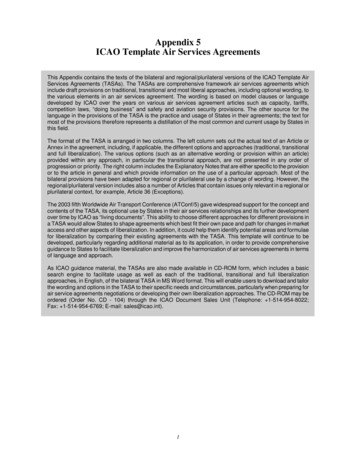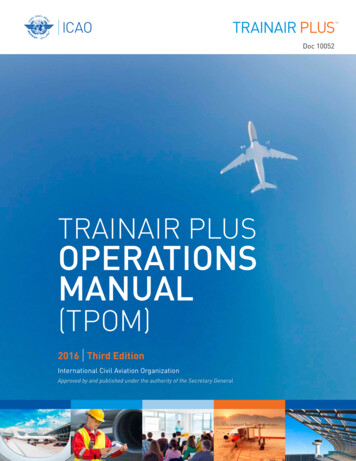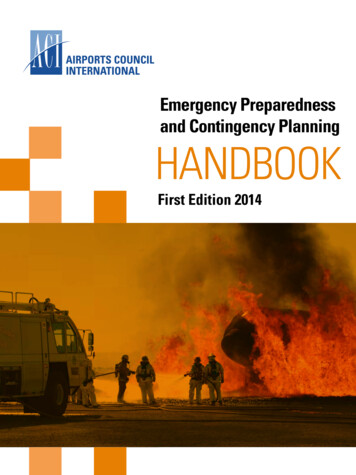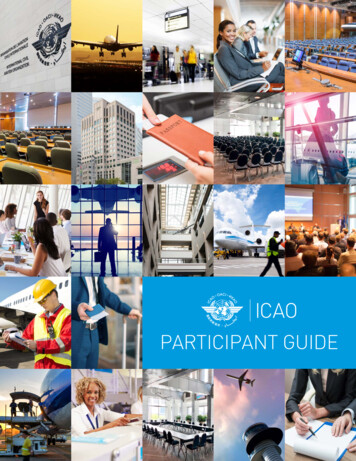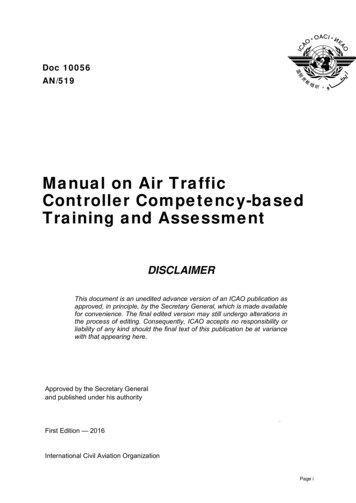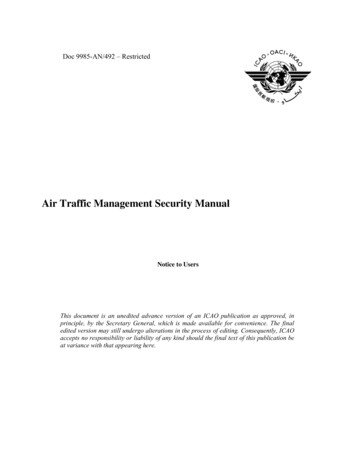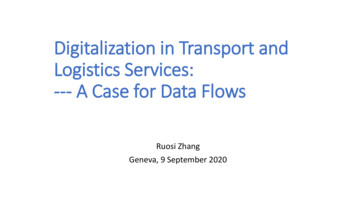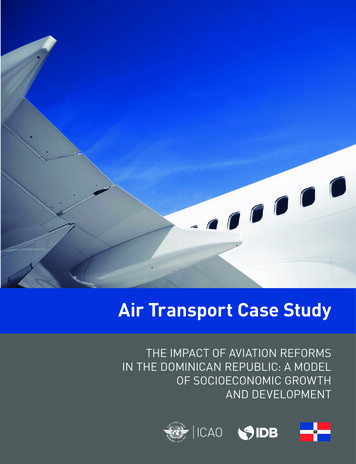
Transcription
Air Transport Case StudyTHE IMPACT OF AVIATION REFORMSIN THE DOMINICAN REPUBLIC: A MODELOF SOCIOECONOMIC GROWTHAND DEVELOPMENT
This study was carried-out by the International Civil Aviation Organization (ICAO), the Inter-American DevelopmentBank (IDB) and Dominican Republic (Instituto Dominicano de Aviación Civil (IDAC) and Cuerpo Especializado enSeguridad Aeroportuaria y de la Aviación Civil (CESAC)).Disclaimer: This guide makes use of information from third parties.All third party content was obtained from sources believed to bereliable and was accurately reproduced in the guide at the time ofprinting. While every effort has been made to ensure the quality andaccuracy of information in this report, it is made available withoutany warranty of any kind.
Air Transport Case StudyTHE IMPACT OF AVIATION REFORMS INTHE DOMINICAN REPUBLIC: A MODELOF SOCIOECONOMIC GROWTH ANDDEVELOPMENTInternational Civil Aviation OrganizationInter-American Development BankDominican Republic
Foreword by ICAOWe are very thankful to the State of Dominican Republic, the Inter-American Development Bank (IDB) and to our ICAOprofessionals for their dedication and contribution towards delivering this Case Study: The impact of aviation reforms inthe Dominican Republic: A model of socioeconomic growth and development.The study, a first of its kind is part of ICAO’s continuing efforts to assist Small Island Developing States (SIDs). It highlights the positive socio-economic impacts of air transport for the Dominican Republic, using data and analysis fromthe past two decades by demonstrating the benefits seen by national economies when States choose to make aviationa priority sector in their national development planning and policies.The study will facilitate further investments and financing for the development of the air transport sector given the forecasted air traffic growth projected for Dominican Republic, a tourism intensive State. It will also serve as a template forother SIDs, as well as Land locked Developing Countries (LLDC) and Least Developed Countries (LDC) to consider andact upon in order to optimize their own air transport benefits.Let us all continue to work together to further enhance this success and support similar strategies that will be neededto ensure the continued enhancement of the aviation sector.Dr. Olumuyiwa Benard AliuPresident ICAO CouncilDr. Fang LiuSecretary GeneralAIR TRANSPORT CASE STUDY: THE IMPACT OF AVIATION REFORMS IN THE DOMINICAN REPUBLIC3
Foreword by IDBThe Latin America and Caribbean region has a very dynamic air transport sector, which recorded a doubling of trafficbetween 2010 and 2018. However, the region faces important challenges. Estimates indicate that countries need to investabout USD 53 billion between 2016-2040 in airport infrastructure to cope with the rising demand. At the same time, atleast 13 countries in the region are below the global average in the effective implementation of the ICAO standards.*1.The Inter-American Development Bank has been working closely with ICAO and our member countries towards closing these gaps and building safer and more reliable air transport services. The work of IDB includes support to nationalreforms, regional integration initiatives, promotion of quality airport infrastructure, and incentives for private sectorparticipation. To date, IDB has approved around USD 640 million in loans in the air transport sector, in addition to various non-reimbursable technical assistances and knowledge products to support policy decisions. Furthermore, one ofour objectives is also evaluate the effectiveness and impact of the interventions in the sector.The Dominican Republic has been one of leading countries in the Region in the transformation of the air transport sector for various reasons: First, recognizing the importance of the sector for tourism and the development of the country,the government committed firmly to include the sector as one of the country’s priorities. Second, important reformstowards the liberalization of the aviation market were approved, by signing open skies agreements and more liberalized ones with key States and by updating the civil aviation law in 2006. Third, institutional and regulatory changes toconform to ICAO safety and security standards have been implemented along the past 10 years. This case study aims toshed the light to these reforms and, mostly, evaluate the impact of the reforms in the civil aviation sector as main drivers of economic envelopment.Miguel Coronado HunterRepresentative of IDB President in Dominican Republic*The Inter-American Development Bank (2018). Developing a More Efficient, Affordable and Safe Aviation Sector in Latin America and the Caribbean:Conceptual Framework for Aviation.4AIR TRANSPORT CASE STUDY: THE IMPACT OF AVIATION REFORMS IN THE DOMINICAN REPUBLIC
Table of Contents1.INTRODUCTION. . . . . . . . . . . . . . . . . . . . . . . . . . . . . . . . . . . . . . . . . . . . . . . . . . . . . . . . . . . . . . . . . . . . . . . . . . . . . . . 72.EXECUTIVE SUMMARY . . . . . . . . . . . . . . . . . . . . . . . . . . . . . . . . . . . . . . . . . . . . . . . . . . . . . . . . . . . . . . . . . . . . . . . . . 83.STATE PROFILE. . . . . . . . . . . . . . . . . . . . . . . . . . . . . . . . . . . . . . . . . . . . . . . . . . . . . . . . . . . . . . . . . . . . . . . . . . . . . . 124.STATE OF AIR TRANSPORT AND CONNECTIVITY. . . . . . . . . . . . . . . . . . . . . . . . . . . . . . . . . . . . . . . . . . . . . . . . . . . 134.1. State of Air Transportation: general statistics, main destinations and airlines . . . . . . . . . . . . . . . . . . . . . 134.2. Dominican Republic Airlines . . . . . . . . . . . . . . . . . . . . . . . . . . . . . . . . . . . . . . . . . . . . . . . . . . . . . . . . . . . . . . 204.3. Cargo Statistics. . . . . . . . . . . . . . . . . . . . . . . . . . . . . . . . . . . . . . . . . . . . . . . . . . . . . . . . . . . . . . . . . . . . . . . . . 214.4. Air Connectivity: Direct Routes, Destinations and Airlines. . . . . . . . . . . . . . . . . . . . . . . . . . . . . . . . . . . . . . 264.5. The Caribbean: Regional Benchmarking . . . . . . . . . . . . . . . . . . . . . . . . . . . . . . . . . . . . . . . . . . . . . . . . . . . . 305.POLICY AND REGULATION. . . . . . . . . . . . . . . . . . . . . . . . . . . . . . . . . . . . . . . . . . . . . . . . . . . . . . . . . . . . . . . . . . . . . 345.1. National Framework for the Air Transport Sector. . . . . . . . . . . . . . . . . . . . . . . . . . . . . . . . . . . . . . . . . . . . . 345.2. Air Services Agreement (ASAs) and Share Code Agreements . . . . . . . . . . . . . . . . . . . . . . . . . . . . . . . . . . . 365.3. Aviation and Environment. . . . . . . . . . . . . . . . . . . . . . . . . . . . . . . . . . . . . . . . . . . . . . . . . . . . . . . . . . . . . . . . . 385.4. Other Policies that have benefited the Aviation Sector . . . . . . . . . . . . . . . . . . . . . . . . . . . . . . . . . . . . . . . . . 406.CIVIL AVIATION SAFETY AND SECURITY OVERSIGHT: REGULATORY FRAMEWORK,OPERATIONS AND CAPACITY BUILDING. . . . . . . . . . . . . . . . . . . . . . . . . . . . . . . . . . . . . . . . . . . . . . . . . . . . . . . . . . 416.1. Regulatory Framework and Operations . . . . . . . . . . . . . . . . . . . . . . . . . . . . . . . . . . . . . . . . . . . . . . . . . . . . . 416.1.1. Aviation Security. . . . . . . . . . . . . . . . . . . . . . . . . . . . . . . . . . . . . . . . . . . . . . . . . . . . . . . . . . . . . . . . . . . . . . . . . 426.1.2. Safety Matters. . . . . . . . . . . . . . . . . . . . . . . . . . . . . . . . . . . . . . . . . . . . . . . . . . . . . . . . . . . . . . . . . . . . . . . . . . . 426.2. Certification of Airplane Ground Handling Services Companies. . . . . . . . . . . . . . . . . . . . . . . . . . . . . . . . . . 436.3. Capacity-Building . . . . . . . . . . . . . . . . . . . . . . . . . . . . . . . . . . . . . . . . . . . . . . . . . . . . . . . . . . . . . . . . . . . . . . . 436.3.1. Superior Academy of Aeronautic Sciences. . . . . . . . . . . . . . . . . . . . . . . . . . . . . . . . . . . . . . . . . . . . . . . . . . . . . 436.3.2. Security and Safety in the Civil Aviation School. . . . . . . . . . . . . . . . . . . . . . . . . . . . . . . . . . . . . . . . . . . . . . . . . 456.3.3. Universidad Nacional Pedro Henríquez Ureña. . . . . . . . . . . . . . . . . . . . . . . . . . . . . . . . . . . . . . . . . . . . . . . . . . 467.NATIONAL AIR NAVIGATION SERVICES. . . . . . . . . . . . . . . . . . . . . . . . . . . . . . . . . . . . . . . . . . . . . . . . . . . . . . . . . . . 477.1. Infrastructure and Personnel. . . . . . . . . . . . . . . . . . . . . . . . . . . . . . . . . . . . . . . . . . . . . . . . . . . . . . . . . . . . . . 497.2. Safety Management System (SMS) . . . . . . . . . . . . . . . . . . . . . . . . . . . . . . . . . . . . . . . . . . . . . . . . . . . . . . . . . 508.SAFETY AUDIT RESULTS AND LACK EFFECTIVE IMPLEMENTATION (EI). . . . . . . . . . . . . . . . . . . . . . . . . . . . . . . 528.1. Background. . . . . . . . . . . . . . . . . . . . . . . . . . . . . . . . . . . . . . . . . . . . . . . . . . . . . . . . . . . . . . . . . . . . . . . . . . . . 538.2. The Dominican Republic Results in the USOAP. . . . . . . . . . . . . . . . . . . . . . . . . . . . . . . . . . . . . . . . . . . . . . . 538.3. Overall Performance of the Dominican Republic. . . . . . . . . . . . . . . . . . . . . . . . . . . . . . . . . . . . . . . . . . . . . . 559.BENEFITS OF AVIATION TO THE DOMINICAN REPUBLIC: AN IMPACT EVALUATION ANALYSIS. . . . . . . . . . . . . 569.1. Policy Evaluation Strategy . . . . . . . . . . . . . . . . . . . . . . . . . . . . . . . . . . . . . . . . . . . . . . . . . . . . . . . . . . . . . . . . 579.2. A Model for GPD per Capita. . . . . . . . . . . . . . . . . . . . . . . . . . . . . . . . . . . . . . . . . . . . . . . . . . . . . . . . . . . . . . . 599.3. Market Results: Microeconomic evidence . . . . . . . . . . . . . . . . . . . . . . . . . . . . . . . . . . . . . . . . . . . . . . . . . . . 649.4. Some considerations on Taxation and Charges. . . . . . . . . . . . . . . . . . . . . . . . . . . . . . . . . . . . . . . . . . . . . . . 719.5. Conclusion. . . . . . . . . . . . . . . . . . . . . . . . . . . . . . . . . . . . . . . . . . . . . . . . . . . . . . . . . . . . . . . . . . . . . . . . . . . . . 7410.POLICIES THAT COULD FURTHER ENHANCE THE ECONOMIC CONTRIBUTION OF CIVIL AIRTRANSPORT IN THE DOMINICAN REPUBLIC. . . . . . . . . . . . . . . . . . . . . . . . . . . . . . . . . . . . . . . . . . . . . . . . . . . . . . 75ANNEX 1: DOMINICAN REPUBLIC AIRLINES. . . . . . . . . . . . . . . . . . . . . . . . . . . . . . . . . . . . . . . . . . . . . . . . . . . . . . . . . . . . . 76ANNEX 2: IMPACT EVALUATION VARIABLES AND ROBUSTNESS CHECKS. . . . . . . . . . . . . . . . . . . . . . . . . . . . . . . . . . . . . 80AIR TRANSPORT CASE STUDY: THE IMPACT OF AVIATION REFORMS IN THE DOMINICAN REPUBLIC5
AcronymsASAsAir Services AgreementsASCASuperior Academy of Aeronautic SciencesCESACDREIESACFIRThe Airport and Civil Aviation Safety and Security BoardDominican RepublicEffective ImplementationSchool of Security and Safety in the Civil AviationFlight Information RegionFODFree On BoardGDPGross Domestic ProductICAOInternational Civil Aviation OrganizationICMIDACJACNCLBSARPsInterdisciplinary Centre for Mathematical and Computational Modelling at University of WarsawDominican Institute of Civil AviationCivil Aviation BoardNo Country Left BehindStandards and Recommended PracticesSDGSustainable Development GoalsSIDSSmall Island Developing StatesUSAPUSOAP6Universal Civil Aviation Security ProgramUniversal Oversight Audit ProgramAIR TRANSPORT CASE STUDY: THE IMPACT OF AVIATION REFORMS IN THE DOMINICAN REPUBLIC
1. IntroductionThe international air transport sector, directly and indirectly, supports the employment of 62.7 million people worldwide.The sector contributes 2.7 trillion dollars in global Gross Domestic Product (GDP), provides 4.1 billion people transportand moves more than a third of world freight by value on 37 million flights each year.In September 2015, Heads of State and Government adopted the United Nations Transforming our World: the 2030 Agendafor Sustainable Development, including its 17 Sustainable Development Goals (SDGs) and 169 targets. The Agenda is acommitment to eradicate poverty and achieve sustainable development by 2030 worldwide. The adoption of the 2030Agenda was a landmark achievement, providing a shared global vision toward sustainable development. The 2030 Agendafor Sustainable Development called special attention to Small Island Developing States (SIDS), as they face unique vulnerabilities in their sustainable development.Achieving the 2030 Agenda’s SDGs will depend on advances in mobility, including air transport that is safe, secure,efficient, economically sustainable and environmentally responsible. While sustainable transport and aviation do nothave a specific SDG, it is widely recognized that both are essential enablers in the achievement of the 2030 Agenda forSustainable Development. In 2017, the International Civil Aviation Organization (ICAO) completed a thorough analysisof how its 2017-2019 Business Plan supports the 2030 Agenda for Sustainable Development. Through this analysis, theOrganization mapped linkages with 15 of the 17 SDGs.In the interest of helping States to have access to the significant socio-economic benefits of safe and reliable air transport, ICAO has launched the No Country Left Behind (NCLB) initiative. This initiative focuses the efforts of the Organizationto assist States in implementing ICAO Standards and Recommended Practices (SARPs), which the main goal is to helpensure that SARPs implementation is harmonized globally.The Dominican Republic (DR), due to its outstanding aviation growth and dynamic interaction with the States and theregion, serves as a model to the Small Island Developing States (SIDS). Other SIDS share many of the same characteristics as the DR, such as the reliance on tourism and air transport as the primary means of transportation. Duringthe past 12 years, the island has emerged as one of the safest and most reliable countries to fly to, owing to a numberof reforms in the aviation sector that brought the nation’s air transport into compliance with the ICAO SARPs. Thesereforms, coupled with other policies to foster tourism on the island, increased the number of passengers who fly to theDominican Republic, thus positively impacting island’s economy.The study describes these reforms from 2006 onwards and measures, through rigorous econometric models, the impactof these reforms on passengers flows to the State as well as the impact on the economy as a whole. The main reformscan be summarized as: modernization of the institutional framework, defining and separating functions between autonomous institutions for each group of activities; liberalization of the aviation market, fostering a free competitive marketand signing air services agreements with more than 60 countries; capacity-building of public officers in order to deliverbetter services; modernization of the international airports and of the air navigation system; incorporation of ICAO SARPsin the internal legal framework; developing the Action Plan for the Mitigation of CO2 emissions in the aviation sector withgoals and measures; and others.This case study provides a more relevant and accurate representation of the impact of such measures on Small DevelopingIsland States (SIDS) as well as other small developing economies, including meaningful insight for civil aviation plannersand relevant ministries (tourism, finance, transport) on the returns on investments generated by the civil aviation sector.Finally, this case study is a specific side-by-side comparison of the aviation sector before and after the (2006) reformswere implemented. The studies also illustrate the difference between a State that does not have political will and commitment in establishing aviation as a national priority versus those that do.AIR TRANSPORT CASE STUDY: THE IMPACT OF AVIATION REFORMS IN THE DOMINICAN REPUBLIC7
2. Executive SummaryDOMINICAN REPUBLIC STATISTICS The air transport market in the Dominican Republic has consistently grown by an average of 5.52% annually overthe last 20 years, making it one of the largest air transport markets among the Caribbean countries. The numberof foreign passengers has increased at a faster pace compared to Dominican nationals, reaching 78% of totalpassengers in 2018, up from 70% in 1996. Regionally, in 2018, 63% of all passengers came from North America, while 19% came from Europe and 6% fromSouth America. The Caribbean accounts for 4.96% of passengers in the air transport market in the DominicanRepublic, third behind the United States and Canada. Only four countries make up more than 67% of passenger flows to the Dominican Republic: the United States,Canada, Spain and Germany. The Dominican air transport sector relies heavily on its ties to the United States. TheU.S. accounted for 50% of the total flow of passengers to the island in 2018. Canada accounts for 12%, Spain 4% andGermany 3%. In 2018, 60 airline carriers provided regular flights to the Dominican Republic, with ten of them making up 64% ofthe market share. JetBlue alone transported an estimated 21% of the total passengers to the Dominican Republic in2018. Low-cost airlines stood out in 2017, accounting for an estimated 45% of all passengers. The number of passengers transported by the Dominican Republic airlines has significantly grown between 2015and 2018, contributing to a better connectivity between DR and Curazao, Cuba, Haiti, Puerto Rico, Saint Martin,British Virgin Islands, Aruba, Antigua and Barbuda and Jamaica. They also performed charter flights to Central andNorth America. The flight movements (entries and exits) reached 5,987 operations in 2016, representing a growth of58.9%. In 2017, the number of flights was 9,865, a growth of 64.8%. The 2045 forecast shows an average growth of CAGR 4% in routes from Central America/Caribbean. In the year 2018, there was around 126.6 million Kg. of freight traffic by air, of which, 83.3 million was exports and43.3 million imports. This cargo translated to a total FOB value of US 5.09 billion, which makes up 20% of the totalimports and exports of the Dominican Republic. Las Americas airport represented almost 60% of the total importsand exports by air. Since 2015, there has been steady, yearly growth in exports, around about 8% annually, highlighted by 2016’s 8.8%growth. The most exported product from the Dominican Republic, by weight, are vegetables (70% of the total); byvalue, stones and precious metals (70% of the total value). In 2018, 75% of exports from the Dominican Republicwent to North America (EUA: 64% and Canada, 11%). There was a significant recovery on imports in 2018 after decreases in 2017. About 65% of the total imports camefrom United States (43%) and China (22%). Machinery and appliances are the most imported products, by air, to theDominican Republic, both FOB-wise (US 806 million) and weight-wise (13.4 million kg.). The island, which accounts for 0.43% of the total passengers in the world, ranked 47th based on 2016 results atthe Global Air Connectivity Index, a World Bank indicator that focuses on understanding the role of connectivity ineconomic growth and development. About 62% of total passengers used a direct flight to travel to DR, 36% madeone stop and 2%, two stops, in 2016. DR has 36 airports, aerodromes and runways, both public (direct administration and concessions) and private. Theinternational airports are administered by the private sector, either through concessions (five) or are privatelyowned (three). By 2018, passengers flew via 242 direct routes from/into 38 countries/territories provided by 43airlines through its 7 operational international airports.8AIR TRANSPORT CASE STUDY: THE IMPACT OF AVIATION REFORMS IN THE DOMINICAN REPUBLIC
The traffic is concentrated in two main airports: Punta Cana (PUJ) and Santo Domingo (SDQ). Around 80% ofpassengers originating in the Dominican Republic departed from these two airports in 2017, through 50% of thetotal routes.POLICY REFORMS DR enacted Law No. 491-06 in December 2006, modernizing legislation to cope with the new aviation landscape,followed by two amendments: Law 67-13 and Law 29-18. The relevant reforms in the aviation sector are: (i) a set of strong institutions to define the air transport policies andto establish the technical and economic regulations of civil aviation, air traffic control, investigation of accidents andsector oversight. The objective is to separate functions among autonomous institutions to avoid conflict of interests;(ii) institutions to define the air transport policies and to establish the technical and economic regulations of civilaviation, air traffic control, investigation of accidents and sector oversight; (iii) More flexibility for foreign operatorsand relaxation of ownership requirements for national operators. Until 2007, the Dominican Republic had signed bilateral agreements with 19 countries, most of them traditional(limited frequencies and routes). However, Law 491-06 established the liberalization of air services in the State.By giving the Civil Aviation Board (JAC, in the Spanish abbreviation) the mandate to sign Air Services Agreements(ASAs) on behalf of the State and a technical staff to carry out the activities, the new law boosted the number ofagreements and moved towards more liberal agreements signed between the Dominican Republic and othercountries, reaching agreements with a total of 66 countries. JAC also accepted more code share agreements after the reforms, as a way to bring about more routes to the State.Currently, there are 15 active code share agreements, which provide 25 routes from Panamá, Spain, the UnitedStates, Guadeloupe, Guyana, and the United Kingdom, involving 15 airlines. The Dominican Republic joined the ICAO-UE capacity building program for CO2 mitigation from internationalaviation. The State defined an Action Plan with goals and mitigation measures. Between 2012-2018, the Dominicanstakeholders invested around USD 13 million in measures to mitigate CO2 emissions, including solar powerplants, equipment to improve energy efficiency in the airports, LED lights, more efficient refrigeration systems,implementation of Preconditioned Air (PCA) units and electronic Ground Power Units (GPU) to reduce the use ofauxiliary power units (APU) and the partial implementation of the Air Traffic Flow Management (ATFM) concept inthe main building of Air Navigation Services Norge Botello. ICAO-UE measured 16.800 CO2 fewer tons of emissionsfrom international flights and airports compared to the 2018 baseline (without project scenario).SECURITY AND SAFETY OVERSIGHT: POLICIES AND CAPACITY BUILDING Similarly, Law 188-11 changed the civil aviation safety and security oversight in the Dominican Republic. Thesechanges included the development of a modern system of sanctions for violations and acts of disobedience. The Airport and Civil Aviation Safety and Security (CESAC) board has released the National Plan for Security andSafety in the Civil Aviation, which led to a group of reforms, such as the implementation of a data center, newtechnologies for inspections, and a video system for airport oversight and simulation. In 2014, the Dominican Republic established its primary law and regulations to certify airplanes ground handlingservices companies. By now, 28 companies have been identified, and five were certified. 18 more are currently goingthrough the certification process under RAD 24 (Dominican Aviation Regulation, in the Spanish abbreviation) and 10have expressed interest but have not started the process. Along the same lines, through the Superior Academy of Aeronautic Sciences (ASCA), the Dominican Republic hastrained 9,265 students under more than 100 academic courses from 2008-2018. The academy also trained 291students on Air Traffic in Aerodromes and Aeronautic Administration, since 2013. Furthermore, ASCA providedcourses for students in many other countries in Latin America and the Caribbean.AIR TRANSPORT CASE STUDY: THE IMPACT OF AVIATION REFORMS IN THE DOMINICAN REPUBLIC9
Through the School of Security and Safety in the Civil Aviation (ESAC), the Dominican Republic trained 6,500professionals on security and safety in civil aviation, and 4525 professionals through 252 courses, from 2009-2018.Among these students, 196 are foreigners from 17 different countries. Under this new reform framework, and due to the commitment of the Dominican Republic toward security issues,major progress was made in the Universal Civil Aviation Security Program (USAP) from 76.46% to 96.98% in 2017,an increase of 20.52 percentage points, reaching high marks in terms of airport security and civil aviation.AIR NAVIGATION SYSTEMS The FIR Santo Domingo (MDCS) has a dimension of 172,578 km2, surrounded by the FIRs of Miami (KZMA), San Juan(TJZS), Curazao (TNCF) and Port-au-Prince (MTEG). The Air Traffic Flow Management Unit was created under the Santo Domingo Area Control Center, with a staff of 13specialists, to monitor and evaluate the traffic situation in the airports and the Santo Domingo Flight InformationRegion (FIR), generating deliverables designed for the optimal execution of air flows. The Air Navigation System is staffed by more than 600 air navigation service provider personnel, 266 aviationtechnical operators and 334 air traffic controllers. The ANS personnel, spread throughout the different airnavigation facilities, supported air navigation services for 215,770 air operations during 2018. The Dominican Republic created the Department of Safety Management, which is a specialized technical bodyresponsible for the implementation of an SMS for air navigation services as well as the subsequent continuousoperation of said system. The Dominican Republic is upgrading its Aviation System Block, starting from Block 0, which has the capacities readyto be implemented with supporting documents such as standards, procedures, specifications and training materials.The State expects to start upgrading Block 1 in 2019, Block 2 in 2025 and Block 3 in 2031, with ICAO’s support.SAFETY AUDIT RESULTS AND LACK OF EFFECTIVE IMPLEMENTATION In 1993, the United States Federal Aviation Administration (FAA) downgraded the Dominican Republic to Category II.Under the new aviation law approved in the Dominican Republic (2006), and the different improvements obtained fromthe new reform framework, the FAA upgraded the Dominican Republic aviation safety rating to Category I in 2007. The first audit under the Universal Safety Oversight Audit Program (USOAP) in the Dominican Republic was carriedout in January 2009, with missions to validate the corrective measures in 2016 and 2017. The State has achievedgreat results in the ICAO’s USOAP, improving the Effective Implementation (EI) from 85.98% (2009) to 90.52% (worldaverage is 66.32%). With these results, the Dominican Republic ranks in the top 5 States in the North America,Central America and Caribbean Region (NACC) in the safety oversight arena (top 4 of 22 in NACC region).THE IMPACT OF AIR TRANSPORT REFORMS IN THE DOMINICAN REPUBLICECONOMY Our macroeconomic model estimated a 15.5% increase in GDP per capita between 2006-2012, which can betranslated in USD 607 per capita of income increase. The microeconomic model estimated an increase between 23% and 27% in the participation of passengers goingto Dominican Republic from the U.S. over passengers going to other destinations. Moreover, due to the policyimprovements, the increase of U.S. tourists to the DR increased tourism spending by USD 836 million to 1.016billion between 2006-2012. The results show a causal relationship between the reforms and the increase ofpassengers, thus impacting positively the economy.10AIR TRANSPORT CASE STUDY: THE IMPACT OF AVIATION REFORMS IN THE DOMINICAN REPUBLIC
Using a conservative estimate, the total net benefit to Dominican Republic in the period of 2006-2012 attributable tothe policy is USD 837 million through American tourist spending, and USD 78 million in taxes charged by the State tonon-residents, reaching a total of USD 915 million. The contribution of taxation to the economy (GDP) of DominicanRepublic is significant. Estimates indicate that for the year 2017, taxation contributed around USD [non-residents 80unit tax] 490 million to the DR economy.AIR TRANSPORT CASE STUDY: THE IMPACT OF AVIATION REFORMS IN THE DOMINICAN REPUBLIC11
3. State ProfileDOMINICAN REPUBLICSocioeconomic IndicatorsAviation IndicatorsPopulation: 10.88 millionNumber of passengers: 13,751,481 (2017)Surface area: 48,671 square kilometersAverage growth total pax (1996-2017): 5.28%Population Density: 224 people per sq kmGlobal Air Connectivity Index (2106): 0.41 (rank 47th World Bank).Category: Small Island Developing StateGDP: 75.93 billion USD (2017)GDP per capita: US 7,052.26 USD (2017)Upper middle-income developing State (Word Bank)Average growth (2000-2016): 4.9%Doing Business Ranking (2018): 99th (World Bank)Global Competitiveness Index (2017-2018): 3.9 out of 7(104th out of 137) (World Economic Forum)Travel & Tourism Competitiveness Index (2017): 76th(World Economic Forum)Logistics Performance Index (2018): 2.66 (87th).Air Liberalization Index (2011): 23 out of 50 (WTO).Global Competitiveness Index - Quality of AirportInfrastructure (2017-2018): 4.8 out of 7 (50th) (WorldEconomic Forum)Airport Infrastructure:36 airports, aerodromes and runways;8 international airports (7 operative)4 public airports (managed by private firms throughconcessions)3 private airports (Punta Cana, La Romana y
the Dominican Republic: A model of socioeconomic growth and development. The study, a first of its kind is part of ICAO's continuing efforts to assist Small Island Developing States (SIDs). It high-lights the positive socio-economic impacts of air transport for the Dominican Republic, using data and analysis from

